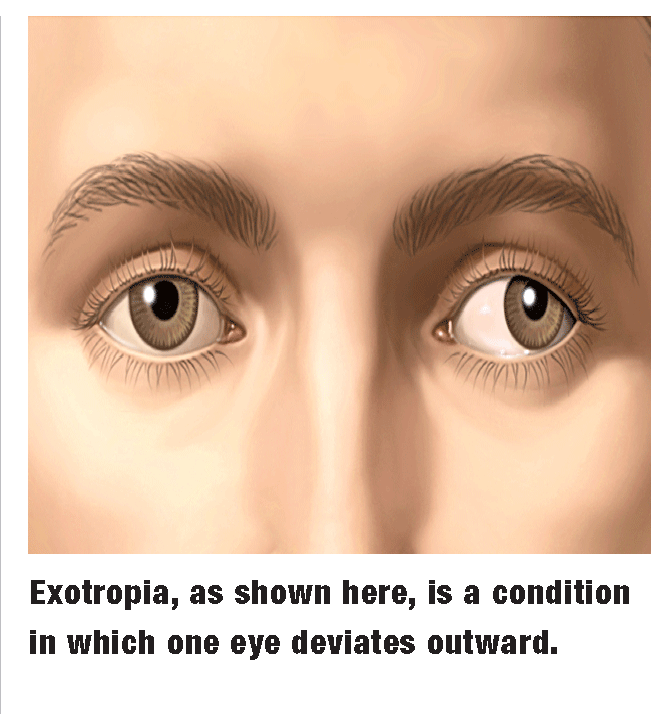 History
History
A 22-year-old black female presented for a scheduled eye examination. She had no significant ocular or systemic history. The patient denied using medications, and reported no allergies.
Diagnostic Data
Her best-uncorrected visual acuity measured 20/20 O.U. Extraocular motility testing at distance uncovered a 40 prism diopter constant alternating exotropia, which was greater in magnitude on up gaze than down gaze.
By observation, the left eye was estimated to be exotropic approximately 90% of the time. Both color and brightness testing were normal. Refraction uncovered negligible error with clear retinoscopic reflexes. Biomicroscopy was unremarkable. Intraocular pressure measured 12mm Hg, O.U. Dilated funduscopy found quiet posterior poles with no peripheral pathology.

Additional examinations included: cover testing at near, which demonstrated no accommodative component; global- and random-dot stereo testing, which indicated a suppressive adaptation and lack of bifoveal fixation; visuoscopy, which showed steady and central fixation O.U.; and Worth 4-dot testing, which uncovered alternating suppression.
Your Diagnosis
How would you approach this case? Does this patient require any additional tests? What is your diagnosis? How would you manage this patient? What is the likely prognosis?
The Diagnosis
This patient has constant alternating, non-comitant, V-pattern basic exotropia, with alternating suppression and steady central fixation.
V-pattern exotropia is a form of strabismus in which the exodeviation is larger in upgaze than in downgaze.1-5 Although the pathophysiology of V-pattern exotropia is not certain, it is generally attributed to overaction of the inferior oblique muscles.1-5 In this instance, the abducting action of the inferior oblique muscles accounts for the V pattern. The diagnosis is supported by the observation of over-elevation in adduction, which is commonly demonstrated in V-pattern exotropia.
Strabismus is often effectively corrected with vision therapy; however, the efficacy of this treatment methodology for V-pattern exotropia has not been entirely confirmed by the existing literature. After extensive discussion with the patient, we determined that surgery was the most appropriate treatment option. Reports of successful surgical treatment for this type of strabismus buttressed our decision.1,3,4,6
There are two surgical alternatives for patients with this condition: myectomy (removal of muscle) or recession of the inferior oblique muscles. Surgery is performed on both eyes to avoid a post-surgical hypertropia.1 The goals of surgery are to reduce the angle of strabismus and close the V (i.e., reduce the difference in angle between downgaze and upgaze). Both procedures have been reported to be successful.1
Additional corrective surgeries are occasionally needed. Specifically, the horizontal rectus muscles may be operated on to reduce the angle of strabismus if the V-pattern has been largely eliminated.1
After strabismus surgery is completed, patients are asked to return to the office for a complete post surgical evaluation. Careful measurements must be taken to document any new angle of strabismus, the continuance of suppression and/or anomalous correspondence, and either return or lack of stereopsis.
In-office vision therapy is recommended, which typically consists of anti-suppression techniques, followed by advice on how to enhance fusional vergence reserves.7-10 Depending on the time of surgery in relation to the sensitive period and surgical repair, vision training has some potential to increase binocularity and depth perception. Patient motivation and compliance with the regimen also effect outcomes.
1. Von Noorden GK,
2. Caloroso EE, Rouse MW. Diagnostic Evaluation of Strabismus. In: Caloroso EE, Rouse MW. Clinical Management of Strabismus.
3. Prieto-Diaz J, Souza-Dias C. A and V-Pattern Deviations. In: Prieto-Diaz J, Souza-Dias C. Strabismus.
4. Biglan AW. Pattern Strabismus. In: Rosenbaum AL,
5. Rutstein RP, Daum KM. Incomitant Deviations. In: Rutstein RP, Daum KM. Anomalies of Binocular Vision: Diagnosis & Management.
6. Cogen MS, Mays A. Medical and Surgical Management of Strabismus. In: Rutstein RP, Daum KM. Anomalies of Binocular Vision: Diagnosis & Management.
7. Birnbaum MH, Klayman IM. Optometric treatment of post-surgical constant exotropia. Am J Optom Arch Am Acad Optom 1972 Nov;49(11):951-3.
8. Ziegler D, Huff D, Rouse MW Success in strabismus surgery: A literature review. Journal of the American Optometric Association 1982;53(12):979-83.
9. Wick B. Visual therapy for constant exotropia with anomalous retinal correspondencea case report. Am J Optom Physiol Opt 1974 Dec;51(12):1005-8.
10. Coffey B, Wick B, Cotter S, et al. Treatment options in intermittent exotropia: a critical appraisal. Optom Vis Sci 1992 May;69(5):386-404.

